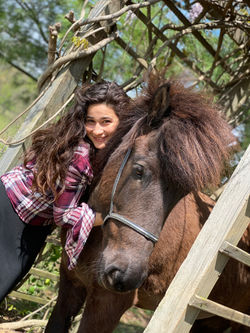![IMG_9202-EFFECTS_Original[580]_edited.jpg](https://static.wixstatic.com/media/0b7cf3_5d29791a7c154a8089db7dac1156ef18~mv2.jpg/v1/fill/w_666,h_312,al_c,lg_1,q_80,enc_avif,quality_auto/IMG_9202-EFFECTS_Original%5B580%5D_edited.jpg)
THE ICELANDIC HORSE
WHAT IS SPECIAL ABOUT ICELANDIC HORSES
For over 1,000 years, the Icelandic horse has been purebred in Iceland. Considered a symbol of fertility, the horse played a pivotal role in Norse culture and history. Throughout history only the best horses were chosen for breeding – picked according to specific characteristics, such as color and equine conformation – meaning that the modern Icelandic horse is the result of many centuries of selective breeding.
The Icelandic horse has survived a lot. From volcanic eruptions to harsh icy winters, this stocky creature has adapted to, and shown its resilience against, the harsh Icelandic climate. More than this, the Icelandic horse is friendly and warm-natured to people – an inheritance from its days at the heart of the Viking clan – and so is thought of fondly by Icelanders and visitors alike.
Indeed, the Icelandic horse is a spirited, strong animal that provides challenging opportunities for competitive riders, while remaining docile and patient enough for beginner riders too.
The Unique Gaits of Icelandic's
The Icelandic horse is capable of all the usual gaits of any other horse – the walk, trot, and canter. However, they possess two unique gaits, the tölt and the skeið, that are thought to have developed in response to a gene mutation.
When Icelandic horses perform the tölt, at least one foot is always in contact with the ground. This fluid movement helps stabilize the ride, removing the usual bounce that a rider experiences and providing a smoother riding experience.
The skeið is a fast, or flying, pace that requires horses to perform a lateral gait – where both legs on one side of the horse simultaneously touch the ground and the horse moves in a manner which closely resembles the human running. Performed at speed, there are points at which no hooves will be in contact with the ground.
To Learn more please Click 'Learn More'
 |  |  |  |  |  |  |
|---|---|---|---|---|---|---|
 |  |  |  |  | ![IMG_9427[598] - Copy](https://static.wixstatic.com/media/0b7cf3_d3b59630d4d74ac6b85d9c41412471a3~mv2.jpg/v1/fill/w_250,h_187,al_c,q_90,enc_auto/0b7cf3_d3b59630d4d74ac6b85d9c41412471a3~mv2.jpg) | ![image0[1728]_edited](https://static.wixstatic.com/media/0b7cf3_3a469659238840b98f5ad1424e20ced1~mv2.jpg/v1/fill/w_250,h_162,al_c,q_90,enc_auto/0b7cf3_3a469659238840b98f5ad1424e20ced1~mv2.jpg) |
![IMG_4305_Original[484]](https://static.wixstatic.com/media/0b7cf3_c6321942dd264ac4afd80560deb80084~mv2.jpg/v1/fill/w_250,h_240,al_c,q_90,enc_auto/0b7cf3_c6321942dd264ac4afd80560deb80084~mv2.jpg) |  | ![IMG_6728[502].JPG](https://static.wixstatic.com/media/0b7cf3_b828028df3ad4774b4f3f9c0dc82b831~mv2.jpg/v1/fill/w_250,h_166,al_c,q_90,enc_auto/0b7cf3_b828028df3ad4774b4f3f9c0dc82b831~mv2.jpg) | ![IMG_9427[598] - Copy.jpg](https://static.wixstatic.com/media/0b7cf3_d3b59630d4d74ac6b85d9c41412471a3~mv2.jpg/v1/fill/w_250,h_187,al_c,q_90,enc_auto/0b7cf3_d3b59630d4d74ac6b85d9c41412471a3~mv2.jpg) |  |  |  |
 | ![IMG_2994_Original[510].jpg](https://static.wixstatic.com/media/0b7cf3_9f38ed7b16644906b3656af4acbc6bdf~mv2.jpg/v1/fill/w_250,h_178,al_c,q_90,enc_auto/0b7cf3_9f38ed7b16644906b3656af4acbc6bdf~mv2.jpg) |  |
